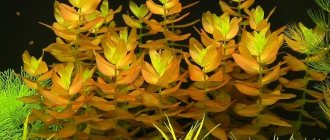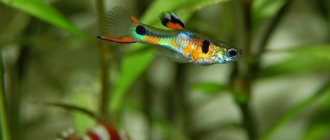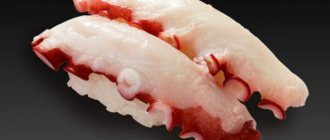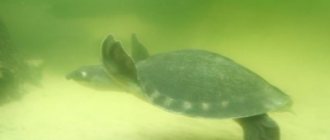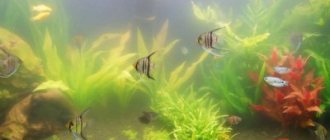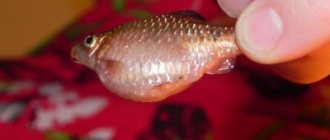Author: Elena N. https://floristics.info/ru/index.php?option=com_contact&view=contact&id=19 Category: Houseplants Published: December 25, 2018Last edits: January 11, 2021
- Hornwort (Ceratophyllum demersum)
Hornwort (lat. Ceratophyllum) is the only genus of monoecious herbaceous perennials in the Hornwort family that develops in the water column of fresh water bodies. There are four species in the genus. In nature, representatives of this genus are distributed everywhere - from the tropics to the Arctic Circle, and in culture this plant is grown for landscaping garden ponds or aquariums.
Planting and caring for hornwort
- Lighting: twelve-hour daylight is needed, but direct sunlight is destructive for the plant.
- Requirements for water in the aquarium: temperature – 24-28 ºC, pH – 6.0-8.0, hardness can be any. There should be no copper impurities in the water.
- Feeding: not needed.
- Reproduction: by cuttings or dividing the stem.
- Diseases: the plant is resistant.
- Pests: not affected.
Read more about growing hornwort below.
Other plant forms
Hornwort submerged
hornwort semi-submerged
Mexican hornwort
Cuban hornwort
Botanical description
You can find hornwort at the depths of a river or reservoir: the plant is extremely shade-tolerant and dies in bright light. The maximum depth at which this hydrophyte was discovered is 9 meters. In favorable conditions, hornwort is capable of growing strongly, displacing other algae.
The plant does not have a root, but to anchor itself in the bottom sediments of natural reservoirs, the hornwort uses whitish rhizoid branches with finely dissected leaves: penetrating into the silt, they anchor the plant in it, like an anchor, and supply it with nutrition, absorbing the necessary substances from the water and soil.
In the photo: Aquarium hornwort
The stem of the hornwort is well defined: dark green or reddish, pubescent, hard due to the silica it contains, it rises from the water, bearing whorls of repeatedly dissected, sessile, hairy leaves, the final finely serrated lobes of which contain lime and upon contact break. In a month, the length of the hornwort stem can increase to 1 m in favorable conditions.
- How to form a money tree and what mistakes in pruning can reduce the decorativeness of the fat plant?
How to grow cabomba in an aquarium - also algae
Sessile unisexual and petalless flowers up to 2 mm long form reduced inflorescences in the leaf axils. Male flowers have many stamens, female flowers have one pistil. Pollination of flowers occurs under water. The fruit of hornworts is a nut with spiny projections.
All parts of the hornwort are covered with a film of cutin, a fat-like substance impermeable to gases and water.
Fertilizers
For nutrition, hornwort has enough substances supplied with water during water changes and fish food. It does not require additional fertilizers or carbon dioxide supply.
Hornwort is a versatile plant that combines well with other plants and is suitable for all types of fish. Its advantages, low maintenance requirements, very rapid growth and reproduction have made it one of the most popular among beginners and experienced aquarists. By planting hornwort in an aquarium, you will receive not only decoration, but also a natural filter.
Keeping hornwort in an aquarium
Growing conditions
Hornworts are unpretentious perennials that can grow in an aquarium for many years, subject to minimum maintenance and care requirements. Conditions for growing hornwort in an aquarium allow temperature fluctuations from 10 to 28 ˚C, but the fastest growth of this algae is observed at 24-26 ˚C. The pH value of water can also vary from slightly acidic to moderately alkaline: pH 6.0-8.0. Hornwort is not picky about water hardness.
As for lighting, despite the shade-loving plant, it needs at least a ten-hour daylight hours, so in late autumn, winter and early spring you will have to organize artificial lighting for it. The power of fluorescent lamps must be at least 0.3 W/l.
However, remember that direct sunlight is harmful to ceratophyllum.
- Flowers for the lazy
Hornwort is compatible with almost any aquarium plants and animals: its cutin-coated leaves do not harm either fish or snails. Only goldfish eat them, thus controlling the too rapid growth of the hydrophyte. To avoid becoming prey for other inhabitants of the reservoir, fry of viviparous fish hide in dense thickets of hornwort.
Hornwort care
Hornwort is a natural water purifier that releases oxygen. The leaves of the hydrophyte absorb ammonium salts, and debris, water suspension, and waste products of aquarium flora and fauna settle on them. Hornwort promotes the rapid oxidation of organic residues and the growth of fry. Based on the above, to filter and aerate the water in an aquarium with ceratophyllum, a low-power filter is sufficient, and the stream should not be directed at the fragile leaves of the plant.
About the correct maintenance of pistia in the aquarium
You can wash off plaque from hornwort leaves under running water, but this must be done very carefully: the leaves are fragile and break off easily. If you find fragments of decaying leaves in the aquarium, you can remove them with a net, but if no rotting is observed on them, leave them in the water, and they will soon give life to new fluffy bushes.
In the photo: Hornwort in an aquarium
Hornwort's lack of roots does not allow it to securely anchor itself to the bottom of the aquarium. Under no circumstances should the stem be buried in the bottom soil or pressed down with a stone: this will most likely cause the stem to rot. How to secure hornwort? You can let the plant float freely in the water, or you can tie the end of its stem with a fishing line to a stone, driftwood, or attached suction cup lying on the bottom. This must be done carefully, without over-tightening the stem.
The aquarium plant hornwort does not need feeding: it only needs the carbon dioxide and nutrients it gets from the water. This is why it is not advisable to use nutrient substrates in aquariums with hornwort. And keep in mind that ceratophyllum does not tolerate copper impurities in water.
With the onset of autumn, in the absence of additional lighting, the hornwort enters a dormant state, sinks to the bottom and may even die, but in the spring, when daylight hours become longer, its shoots will produce new shoots. The same process occurs in open bodies of water: over the winter, the hornwort stems turn black and die, but the buds on them are able to survive even at very low temperatures, and in early spring shoots will begin to grow from them.
- Jatropha (Jatropha) – care, photos, types
How to care for Cryptocoryne in an aquarium
Hornwort propagation
Hornwort propagates vegetatively: by dividing the stem or by cuttings. A cutting or piece of stem with leaves is left floating in water or tied to a stone and it will begin to grow quickly.
Beneficial features
Hornwort is practically indispensable when starting a new aquarium, because it is very important to establish a biological balance in it as soon as possible. Living plants play an important role in the process of forming and maintaining proper chemical balance. But while other plants need quite a long time to adapt and start growing, hornwort begins to grow and “work” almost instantly. This helps avoid unwanted outbreaks of ammonia nitrites and nitrates in a new aquarium. And significantly reduce the time to establish balance.
The beautiful and unpretentious hornwort also has a number of useful properties for the aquarium:
- Helps cleanse the aquarium of algae;
- purifies water from suspended substances and feed residues;
- fry and small fish take refuge in the fluffy leaves of hornwort.
Pests and diseases
Hornwort is very resistant to both diseases and pests. Due to the tannin content in its leaves, the plant is not damaged even by snails that eat other algae. Hornwort can only suffer from inappropriate conditions or poor care. For example, when exposed to direct sunlight, the plant turns yellow, and its damaged areas have to be cut off.
If somehow a fungus is introduced into the aquarium, its plaque must be washed off the hornwort with running water, after which the plant should be disinfected in a weak solution of potassium permanganate or fungicide. However, fungal infections of hornwort are very rare.
Spreading
Hornwort is a non-capricious plant, due to which its habitat occupies the entire temperate climate zone. From the Arctic Circle to the hot and humid tropics, it is easily found in slow-moving rivers and lakes.
Types and varieties
Hornwort (Ceratophyllum demersum)
Or dark green hornwort, or submerged hornwort, or triaxial hornwort, or submerged hornwort - the type species of the genus, a perennial rootless aquatic plant from North America, free-floating or attached to the substrate with rhizoid shoots. The stems of the plant can reach a length of 2.5 m. The sessile leaves of the hornwort, painted in different shades of green from dark to olive, are located along the stem in whorls. Greenish flowers up to 2 mm long can be male with many stamens or female with one pistil. Fruits are rarely formed in aquarium conditions.
In the photo: Submerged hornwort (Ceratophyllum demersum)
Hornwort (Ceratophyllum submersum)
Or light green hornwort , a submerged dicotyledonous perennial plant with small green flowers and soft, segmented, thread-like leaves colored light green. Under the sun's rays, the leaves lighten to a yellow-light green hue.
In the photo: Semi-submerged hornwort (Ceratophyllum submersum)
In addition to the two main species, the following varieties of hornwort are also grown in aquariums:
- Foxtail is a hydrophyte from Bolivia with a dense arrangement of plates. The leaves of this variety are not as fragile as those of other hornworts. The length of the foxtail stems reaches 80 cm. A characteristic feature of the plant is its light-loving nature: the hornwort develops better and acquires “fluffiness” under bright light in the upper layers of water;
- Cuban hornwort is a hardy, highly decorative variety that continues to grow and develop even in winter. The shoots of the Cuban hornwort are fluffy, similar to the paw of a spruce, with reddish stems and internodes located close to each other.
Reproduction
Reproduction of ceratophyllum in an aquarium is an easy process, since the plant is characterized by vigorous growth and constantly produces new young shoots. There are two ways to propagate hornwort:
- Seeds.
- Vegetatively (by division).
The second method is the most popular - by dividing the stems. To propagate a plant using this method, you must carefully trim the young shoots growing at the top and leave the cut branches floating next to the adult flower. If rooting in the ground is required, then freshly cut shoots are planted in the substrate, secured with stones or snags. It should be noted that in some cases the shoots detach from the mother plant on their own. In this case, the separated shoots are monitored to prevent the branches from rotting.
You can increase the number of new flowers by dividing the cut shoot into parts. To grow a new ceratophyllum, a small piece is enough - 5 cm or more.
Ceratophyllum in an aquarium is an interesting and surprising plant that decorates the underwater space and benefits fish and shellfish. The popularity of the green flower is due to its many advantages: unpretentiousness, rapid growth, and beauty. Having planted ceratophyllum in an artificial pond, you should not forget to care for the green resident, cutting off dense thickets and washing the foliage with warm water.
How to plant?
Most aquarists do not plant hornworts, but leave the new plants to float freely in the pond. But a free-floating plant often grows into a complex nodular formation that cannot be untangled by any means. special suction cups for planting Planting material is carefully attached to them with a fishing line, and the suction cups are fixed to the bottom or walls of the aquarium. This method greatly facilitates subsequent care: it is convenient to remove plants from the container for washing and removing rotten areas.
There is no need to add nutritional supplements to the bottom substrate, since hornworts do not have roots and feed entirely from the aquatic environment.
Application
Hornwort can be used to green up your home aquarium quickly and inexpensively. This primarily concerns beginners who cannot provide comfortable conditions for more demanding plants.
In addition to decoration, it is used as plant food for some aquarium fish. Fry and shrimp love to hide in it. The plant is placed in spawning tanks.
The plant is also allowed to float on the surface of the water to shade shade-loving plant species, such as anubias and cryptocorynes. In aquariums without a lid, hornwort floating on the surface of the water prevents the fish from jumping out of the aquarium.
Why isn't it growing?
If you started a plant, waited until the end of the adaptation period, and do not notice any growth, look for the source of the problem not in the plant, but in the environment.
Reasons for lack of growth:
- change in plant water parameters after transplantation;
- algae hypothermia;
- low nitrate content;
- lack of oxygen;
- deficiency of light or its excess.
The same reasons lead to stunted growth or yellowing of the plant. If you notice that the foliage has fallen or the stem has begun to rot, turn yellow, or change structure, check the specified parameters and bring them into compliance. You will save the plant and restore its growth.
